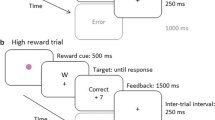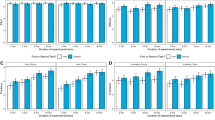Abstract
Two tasks where failures of cognitive control are especially prevalent are task-switching and spatial Simon task paradigms. Both tasks require considerable strategic control for the participant to avoid the costs associated with switching tasks (task-switching paradigm) and to minimize the influence of spatial location (Simon task). In the current study, we assessed whether the use of a self-regulatory strategy known as “implementation intentions” would have any beneficial effects on performance in each of these task domains. Forming an implementation intention (i.e., an if–then plan) is a self-regulatory strategy in which a mental link is created between a pre-specified future cue and a desired goal-directed response, resulting in facilitated goal attainment (Gollwitzer in European Review of Social Psychology, 4, 141–185, 1993, American Psychologist, 54, 493–503, 1999). In Experiment 1, forming implementation intentions in the context of a task-switching paradigm led to a reduction in switch costs. In Experiment 2, forming implementation intentions reduced the effects of spatial location in a Simon task for the stimulus specified in the implementation intention. Results supported the prediction that the need for high levels of cognitive control can be alleviated to some degree by making if–then plans that specify how one responds to that critical stimuli.






Similar content being viewed by others
Notes
On a German computer keyboard, these keys are located symmetrically on the left and right sides of the keyboard.
References
Aarts, H., Dijksterhuis, A., & Midden, C. (1999). To plan or not to plan? Goal achievement of interrupting the performance of mundane behaviors. European Journal of Social Psychology, 29, 971–979.
Allport, D. A., Styles, E. A., & Hsieh, S. (1994). Shifting intentional set: Exploring the dynamic control of tasks. In C. Umilta & M. Moscovitch (Eds.), Attention and performance XV: Conscious and nonconscious information processing (pp. 421–452). Hillsdale, NJ: Erlbaum.
Bandura, A. (1986). Social foundations of thought and action: A social cognitive theory. Englewood Cliffs, NJ: Prentice Hall.
Bargh, J. A. (1989). Conditional automaticity: Varieties of automatic influence in social perception and cognition. In J. S. Uleman, & J. A. Bargh (Eds.), Unintended thought (pp. 3–51). London: Guilford Press.
Bargh, J. A. (1994). The four horsemen of automaticity: Awareness, intention, efficiency, and control in social cognition. In R. S. Wyer, Jr. & T. K. Srull (Eds.), Handbook of social cognition, Vol. 1: Basic processes (2nd ed.) (pp. 1–40). Hillsdale, NJ: Erlbaum.
Bargh, J. A., Gollwitzer, P. M., Lee-Chai, A. L., Barndollar, K., & Troetschel, R. (2001). The automated will: Nonconscious activation and pursuit of behavioral goals. Journal of Personality and Social Psychology, 81, 1014–1027.
Broadbent, D. E. (1958). Perception and communication. London: Pergamon Press.
Chasteen, A. L., Park, D. C., & Schwarz, N. (2001). Implementation intentions and facilitation of prospective memory. Psychological Science, 12, 457–461.
Cohen, A.-L., Jaudas, A., & Gollwitzer, P. M. (2005). Working memory load and self-regulatory strategies modulate the cost of remembering to remember. Paper presented at the 2nd meeting of the international conference on prospective memory, Zurich, Switzerland.
De Jong, R., Liang, C.-C., & Lauber, E. (1994). Conditional and unconditional automaticity: A dual-process model of effects of spatial stimulus-response correspondence. Journal of Experimental Psychology: Human Perception & Performance, 20, 731–750.
Dreisbach, G., Haider, H., & Kluwe, R. H. (2002). Preparatory processes in the task-switching paradigm: Evidence from the use of probability cues. Journal of Experimental Psychology: Learning, Memory, and Cognition, 28, 468–483.
Gollwitzer, P. M. (1993). Goal achievement: The role of intentions. European Review of Social Psychology, 4, 141–185.
Gollwitzer, P. M. (1999). Implementation intentions: Strong effects of simple plans. American Psychologist, 54, 493–503.
Gollwitzer, P. M., & Schaal, B. (1998). Metacognition in action: The importance of implementation intentions. Personality and Social Psychology Review, 2, 124–136.
Gollwitzer, P. M., & Sheeran, P. (2006) . Implementation intentions and goal achievement: A meta-analysis of effects and processes. Advances in Experimental Social Psychology, 38, 69–119.
Hahn, S., Andersen, G. J., & Kramer, A. F. (2003). Multidimensional set switching. Psychonomic Bulletin & Review, 10, 503–509.
Hommel, B. (1993). Inverting the Simon effect intention: Determinants of direction and extent of effects of irrelevant spatial information. Psychological Research Psychologische Forschung, 55, 270–279.
Hommel, B. (1997). Interactions between stimulus-stimulus congruence and stimulus–response compatibility. Psychological Research Psychologische Forschung, 59, 248–260.
Hommel, B., Proctor, R. W., & Vu, K-P. L. (2004). A feature-integration account of sequential effects in the Simon task. Psychological Research/Psychologische Forschung, 68, 1–17.
Kornblum, S., Hasbroucq, T., & Osman, A. (1990). Dimensional overlap: Cognitive basis for stimulus–response compatibility–A model and taxonomy. Psychological Review, 97, 253–270.
Lu, C-H., & Proctor, R. W. (1995). The influence of irrelevant location information on performance: A review of the Simon and spatial Stroop effects. Psychonomic Bulletin & Review, 2, 174–207.
Mayr, U., & Kliegl, R. (2003). Differential effects of cue changes and task changes on task-set selection costs. Journal of Experimental Psychology: Learning, Memory, and Cognition, 29, 362–372.
Meiran, N., & Chorev, Z. (2005). Phasic alertness and the residual task-switching cost. Experimental Psychology, 52, 109–124.
Monsell, S. (2003). Task switching. Trends in Cognitive Sciences, 7, 134–140.
Mordkoff, J. T. (1998). Between-dimension flanker effects: A clarification with encouraging implications. Psychonomic Bulletin & Review, 5, 670–675.
Proctor, R. W., & Lu, C-H. (1999). Processing irrelevant location information: Practice and transfer effects in choice-reaction tasks. Memory & Cognition, 27, 63–77.
Ratcliff, R. (1979). Group reaction time distributions and an analysis of distribution statistics. Psychological Bulletin, 86, 446–461.
Rogers, R. D., & Monsell, S. (1995). Costs of a predictable switch between simple cognitive tasks. Journal of Experimental Psychology: General, 124, 207–231.
Schneider, W. (1988). Micro-Experimental Laboratory: An integrated system for IBM PC compatibles. Behavior Research Methods, Instruments, & Computers, 20, 206–217.
Shallice, T. (2005). The fractionation of supervisory control. In M. S. Gazzaniga (Ed.).The cognitive neurosciences III. Cambridge, MA: MIT Press.
Simon, J. R. (1990). The effects of an irrelevant directional cue on human information processing. In R. W. Proctor & T. G. Reeve (Eds.), Stimulus–resopnse compatibility: An integrated perspective (pp. 31–86). Amsterdam: North-Holland.
Sohn, M-H., & Anderson, J. R. (2001). Task preparation and task repetition: Two-component model of task switching. Journal of Experimental Psychology: General, 130, 764–778.
Stürmer, B., Leuthold, H., & Sommer, W. (1998). Strategische Effeckte und kurzfristige Modulationen im Simon-Paradigma [Strategic effects and short-term modulations in the Simon paradigm] [Abstract]. In H. Lachnit, A. Jacobs, & F. Rösler (Eds.), Experimentelle Psychologie: Abstracts der 40. Tagung experimentellareitender Psychologen (pp. 365–366). Lengerich: Pabst Science Publishers.
Stürmer, B., Leuthold, H., Soetens, E., Schröter, H., & Sommer, W. (2002). Control over location-based response activation in the Simon task: Behavioral and electrophysiological evidence. Journal of Experimental Psychology: Human Perception and Performance, 28, 1345–1363.
Tagliabue, M., Zorzi, M., Umiltà, C., & Bassignani, F. (2000). The Role of Long-Term-Memory and Short-Term-Memory Links in the Simon Effect. Journal of Experimental Psychology: Human Perception and Performance, 26, 648–670.
Vu, K-P. L., Proctor, R. W., & Urcuioli, P. (2003). Transfer effects of incompatible location-relevant mappings on a subsequent visual or auditory Simon task. Memory & Cognition, 31, 1146–1152.
Waszak, F., Hommel, B., & Allport, A. (2003). Task-switching and long-term priming: Role of episodic stimulus-task bindings in task-shift costs. Cognitive Psychology, 46, 361–413.
Webb, T. L., & Sheeran, P. (2003). Can implementation intentions help to overcome ego-depletion? Journal of Experimental Social Psychology, 39, 279–286.
Wylie, G., & Allport, A. (2000). Task switching and the measurement of "switch costs." Psychological research/Psychologische Forschung. Special Executive Control, 63, 212–233.
Author information
Authors and Affiliations
Corresponding authors
Rights and permissions
About this article
Cite this article
Cohen, AL., Bayer, U.C., Jaudas, A. et al. Self-regulatory strategy and executive control: implementation intentions modulate task switching and Simon task performance. Psychological Research 72, 12–26 (2008). https://doi.org/10.1007/s00426-006-0074-2
Received:
Accepted:
Published:
Issue Date:
DOI: https://doi.org/10.1007/s00426-006-0074-2




